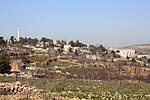Yeshivat Har Etzion
Educational institutions established in 1968Gush EtzionYeshivas in the West BankYeshivat Har EtzionYeshivot hesder

Yeshivat Har Etzion (YHE; Hebrew: ישיבת הר עציון), commonly known in English as "Gush" and in Hebrew as "Yeshivat HaGush", is a hesder yeshiva located in Alon Shvut, an Israeli settlement in Gush Etzion. It is considered one of the leading institutions of advanced Torah study in the world and with a student body of roughly 480, it is one of the largest hesder yeshivot in the West Bank.
Excerpt from the Wikipedia article Yeshivat Har Etzion (License: CC BY-SA 3.0, Authors, Images).Yeshivat Har Etzion
HaYeshiva,
Geographical coordinates (GPS) Address Nearby Places Show on map
Geographical coordinates (GPS)
| Latitude | Longitude |
|---|---|
| N 31.6577 ° | E 35.1233 ° |
Address
HaYeshiva
Judea and Samaria, Palestinian Territories
Open on Google Maps








